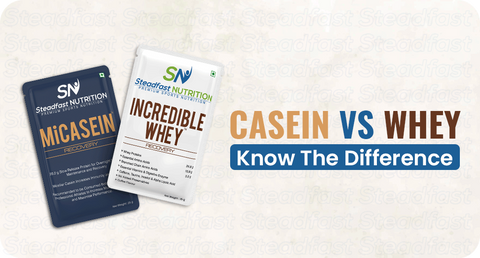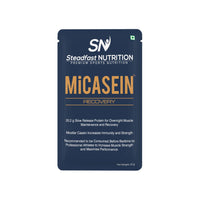Casein and whey protein are the highest-quality proteins derived from milk, containing all nine essential amino acids, required for muscle protein synthesis and repair. Our body can’t make these amino acids, making it necessary to take them through food or supplements.
Casein and whey differ in their absorption time and bioavailability.
Casein is a protein found in milk that gives it its white color. Casein protein forms 80% of the protein content in milk, while the remaining 20% is whey protein. Other sources of casein include yogurt and cheese. Casein contains slow-releasing amino acids, which are digested more slowly than milk, making it ideal for sustained muscle recovery. It’s popularly called night protein since people take it to recover and reduce muscle breakdown while they sleep.
Like Casein, whey is a by-product of cheese production formed by adding enzymes to heated milk, causing it to turn to cheese. The curd formed as a by-product is casein, while the liquid is whey. Whey is taken to improve athletic performance, expedite muscle recovery, and fulfill nutritional deficiencies. Add whey protein to milk and consume as whey milk or mix with water, smoothies and soft foods such as porridge.
What is the difference between Whey and Casein Powder?
1. Difference in Protein absorption rates
The body breaks down protein into amino acids that circulate in the bloodstream till absorbed. Amino acids released by casein stay elevated in the blood for four to five hours after consumption, whereas those released by whey remain in the bloodstream for 90 minutes. These two proteins thus have different absorption rates.
Casein interacts with the acids in the stomach to form curd, which takes time to digest and absorb, providing the body with a slow, balanced release of amino acids and making it best for taking before fasting or sleeping.
On the other hand, whey is absorbed more quickly than casein and is best taken after a workout for muscle repair and rebuilding.
2. Difference in muscle protein synthesis
One difference between casein and whey is their ability to stimulate muscle building. Whey protein contains more of the branched-chain amino acids (BCAAs) leucine, valine, and isoleucine, whereas casein contains more of the amino acids histidine, methionine, and phenylalanine. While all essential amino acids are necessary for muscle building, leucine stimulates the maximum muscle protein synthesis.
Whey, which has a higher leucine content, stimulates muscle growth more than casein, especially when combined with a workout.
There is no finding yet on whether greater stimulation of the muscle growth process results in more muscle growth in the long term. However, supplementing with protein over time definitely leads to increased muscle strength, endurance, and size.
Casein vs Whey: Difference in bioactive compounds
Casein is a good source of bioactive peptides that boost immunity, digestive health, lower blood pressure, and reduce blood clot formation. It contains casokinins- peptides that have the same effect as angiotensin-converting enzyme (ACE) inhibitors, a class of drugs commonly prescribed to control blood pressure. The peptides also have free-radical-scavenging properties, which may help fight cancer.
Whey is rich in active proteins- immunoglobulins- which boost immune health by slowing the growth of harmful microorganisms. It’s also high in specific dipeptides that promote the synthesis of glutathione, an antioxidant that helps in cell repair and protection. Whey protein also contains ACE-inhibitory peptides, lactokinins, that control blood pressure. A whey protein-rich diet is also associated with an increased release of the hormone cholesystokinin that suppresses appetite, helping in weight loss.
Casein vs Whey - Difference in Nutrition Value
Casein contains more carbohydrates and calories but the same amount of fat and protein than whey.
31 g of whey protein provides 110 calories, 24 g protein, 1 g fat, and 2 g carbohydrates; by comparison, 34 g of casein protein provides 120 calories, 24 g protein, 1 g of fat, and 4 g of carbohydrates.
Both casein and whey are derived from milk. They have different absorption rates- casein digests slowly and is best taken after a workout or before sleeping to prevent muscle breakdown and sustain muscle recovery.
Take whey protein immediately after a workout for quick muscle recovery.
Steadfast Nutrition’s Whey Unflavoured provides 20 g of fast-releasing protein per serving of 25 g, which are quickly absorbed and digested and help in quick muscle recovery. It’s free of any flavor, color or food additives.
Mix the protein powder in milk for best results.
Steadfast Nutrition’s MiCasein provides 20.2 g of slow-releasing protein per serving of 25 g, for sustained muscle recovery. It contains micellar casein, which takes long to digest, providing a steady and gradual release of amino acids for overnight recovery. Take MiCasein before bedtime or with a meal.



